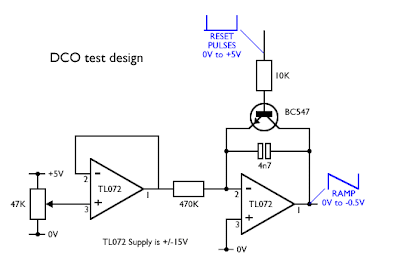
This came in on the SDIY list via Tom Wiltshire. I thought it would be an interesting post on how these things get started and Tom gave me the ok to put it.
"Hi All,
I've been experimenting with a DCO design based on the Roland JX8P circuit
Broadly speaking, it works, in that I can get a ramp wave out of it if I adjust the 47K pot on the left. This pot and op-amp buffer will be replaced by a DAC when I get it working better. I've got reset pulses generated by a PIC being fed into the base of the transistor at 440Hz for the purposes of the test. That part is fine.
The problem is that the output goes from 0V down to -0.5V and then seems to saturate. What's going on? How can the op-amp output be saturated at only -0.5V when it's running on +/-15V rails? Everything I've read suggests that the output from an integrator ought to carry on as far as the op-amp output can take it, so I was expecting a ramp from 0V down to -15V or thereabouts. I'm sure there's something I'm missing here...
Thanks for any clues,
Tom"
Some clues did come in from members of the list including:
"Looks to me like base-collector parasitic diode starts conducting."
and
"The ramp is negative going, so Vcb is negative. That causes the base collector junction of your reset transistor to forward bias and limit the output voltage. You'll need to rethink the way you've got that reset transistor hooked up, or reverse the direction of the ramp so it's positive going (hint - invert the input to the integrator)."
followed by:
"Thanks both, that's sorted it. I simply swapped the polarity going into the integrator and as if by magic everything became hunkydory.
What I was missing was that Roland were evidently using a negative voltage. That isn't immediately clear from the schematic.
Instant solutions on this list...great suff!"
Why post this? Again, it's and interesting insight for those not involved in the SDIY community to see how some of this happens. Who knows, we might have a very nice Roland JX-8P VCO module or the like available one day. Pretty cool...
The
Juno-106 replacement chips immediately come to mind.











































